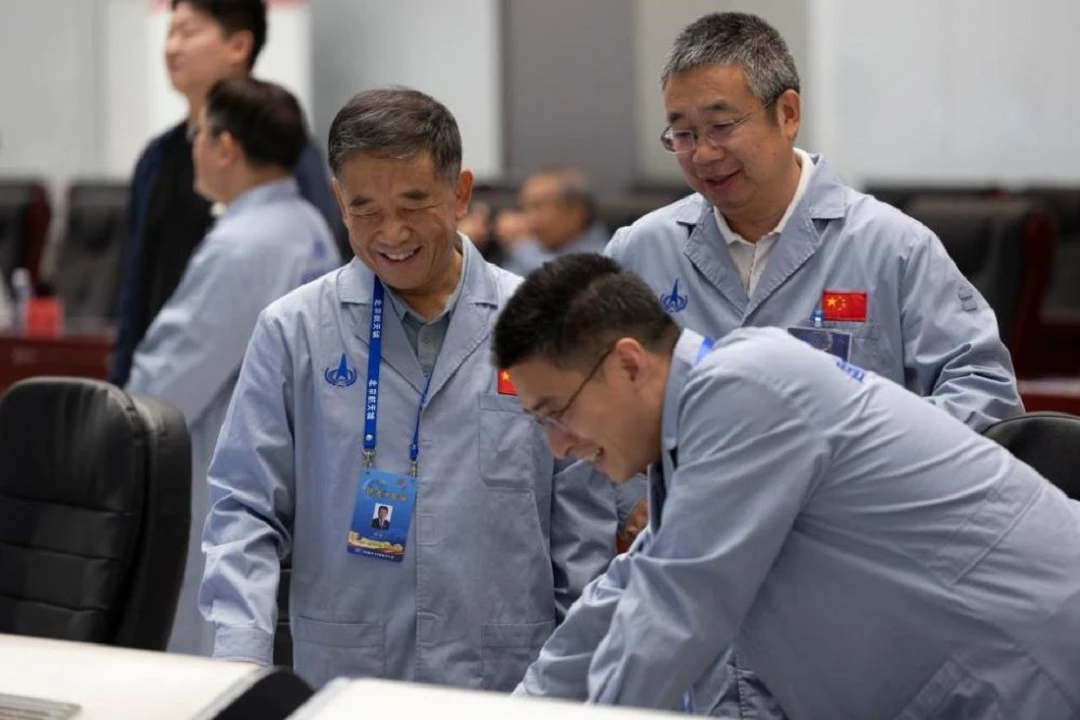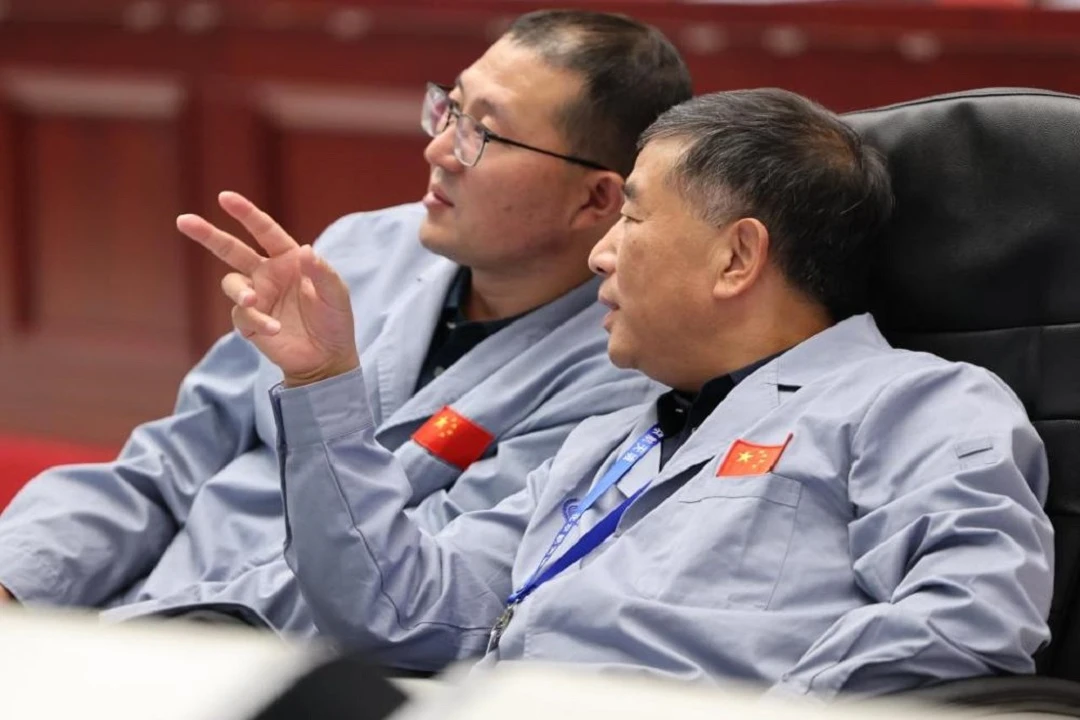In the vast expanse of Inner Mongolia's Siziwang Banner, amidst the serene landscapes of Amugulang Grassland, a historic moment unfolded on June 25th at 2 PM. It was here that Hu Hao, the chief designer of the Chang'e 6 mission, welcomed back the long-awaited "Moon Maiden (六姑娘)" after 53 days of anticipation—the Chang'e 6 probe, marking humanity's first-ever lunar far-side sample return.
Unveiling the Triumph
Positioning, searching, checking status—the returner functioned flawlessly, achieving a resounding success for the mission, finally putting Hu Hao's anxieties to rest.
Even as Chang'e 6 faithfully brought back nearly 4 kilograms of lunar soil from the far side of the moon, Hu Hao remains tirelessly occupied these days: escorting the returner back to Beijing, overseeing the unpacking of the lunar samples, planning future orbital experiments, and witnessing the initiation of scientific research on the lunar samples. Amidst his busy schedule, he shared with Xinhua News Agency reporters for the first time the untold stories of Chang'e 6.
Technological Feats
Collecting 1935.3 grams of the first human lunar far-side sample, and achieving a more precise re-entry than Chang'e 5, international payloads also harvested a scientific data "bonanza". Discussing the accomplishments of the "Moon Maiden," Hu Hao's face exuded pride and his voice rang with cheerfulness.
"The Chang'e 6 mission is China's most complex deep-space exploration mission to date, with numerous flight control events, tight timelines, and complex control processes," Hu Hao explained. "The 'Moon Maiden' used intelligent rapid sampling technology, increasing operational efficiency by approximately 30% compared to Chang'e 5. Based on the geological conditions and drilling operations at the landing site, the final drilling depth reached 1.1 meters."
The landing precision of the returner reflects the mission's technological control level. The Chang'e 6 returner's landing prediction accuracy was within a dozen meters, parachute deployment accuracy within 200 meters, and landing accuracy within 16 kilometers, completing the final step of returning home with high quality.
International Collaboration and Future Prospects
Chang'e 6 carried four international scientific payloads, reaping substantial gains from this journey. Among them, the French radon detector transmitted 158 megabytes of scientific data, while the European Space Agency's lunar surface negative ion analyzer sent back 3.9 megabytes of scientific data. Both projects have entered the final stages of data processing and paper preparation. The Italian laser corner reflector essentially "nailed a nail" on the moon's surface, aiding in future lunar missions' positional calibration.
"The international cooperation of the 'Moon Maiden' has exceeded expectations, enhancing our international influence in lunar exploration and promoting friendly exchanges with payload-carrying countries," said Hu Hao.
On June 28th, the lunar samples were formally handed over to the Chinese Academy of Sciences, the leading unit for lunar scientific research. Hu Hao could hardly contain his excitement: "What new knowledge will the 'Moon Maiden' bring? I am full of anticipation."
"Pushing the Limits of Plans," Finding Certainty in Uncertainty
Over the past three years, Hu Hao has led his team in extensive adaptation and optimization designs, achieving significant technological breakthroughs in lunar retrograde orbit design and control, intelligent lunar sampling, lunar takeoff and ascent, making Chang'e 6 the most technically advanced lunar exploration mission in Chinese aerospace history.
The greatest suspense lay in whether it could accurately land in the designated area on the lunar far side. The moon's map has low accuracy, with a maximum resolution of only about two meters, and due to the lack of real-time image data on the lunar far side, judgments rely solely on telemetry data. The sampling process was akin to "opening a blind box." Due to the inability to predict the lunar surface conditions in advance, drilling and surface collection were designed as "mutual backups." If drilling failed, relocating would be costly, necessitating a "fallback" through surface collection.
"The reliability of the Chang'e 6 mission is a product relationship: if one link is 0.9, then another link is 0.9, the overall system reliability drops to 0.81," reflecting back on it now, it sounds light-hearted, but every step was heart-stopping. For instance, implementing unmanned sampling, encapsulation, and transfer on the lunar far side demanded high precision and difficulty. Moreover, the moon's high vacuum meant any atmospheric entry could potentially contaminate the samples. The development team conducted extensive experiments on the ground simulation platform to ensure sample consistency with millimeter-level accuracy.
"We pushed the plan to its limits, seeking certainty in uncertainty; even if the relay satellite malfunctioned, Chang'e 6 could still independently conduct sampling and take off," Hu Hao explained, gesturing succinctly, clean and without redundancy.
Spacefarers are Engaged in a New Battle
In 2007, the Chang'e 1 probe, based on Earth orbit satellites, weighed only 2.35 tons. In 2024, the Chang'e 6 mission sent an over 8-ton probe to the moon, signifying a significant leap in China's capability to send probes into space over the past 17 years. Accompanying "Chang'e" throughout its growth, Hu Hao has experienced several identity transitions from deputy commander to chief designer. What remains unchanged is "always facing new problems, and embracing new challenges."
Outer celestial body sampling and encapsulation, unmanned lunar orbit rendezvous docking, re-entry and return at nearly the second cosmic speed... In 2020, with Hu Hao serving as chief designer, the Chang'e 5 mission achieved several "Chinese firsts," marking significant technological leaps.
"Fear of seeing tigers and venomous snakes at the door is not scary; you can find ways to deal with them. What's terrifying is the pitch-blackness outside the door. Should we take the step forward?" Hu Hao used a vivid metaphor to convey the immense pressure and challenges of venturing into the unknown.
One innovation breakthrough after another, one challenge overcome after another, Hu Hao summarizes his feelings over the years with four "faiths": "Strong belief enables ten years of sword sharpening, advancing towards a common dream; maintaining confidence allows us to face new challenges and achieve breakthroughs; mutual trust unifies our efforts in complex large-system engineering, coordinating to overcome challenges; keeping promises makes domestic and foreign related units willing to cooperate with us."
The blueprint for the future has been drawn up, aiming to achieve manned lunar landing by 2030 and establish the basic model of an international lunar research station by 2035. "Chang'e 5 and Chang'e 6 have proven that the technical route designed by the Chinese for round-trip lunar missions is feasible," Hu Hao confidently concluded, "Spacefarers are engaged in a new battle!"



